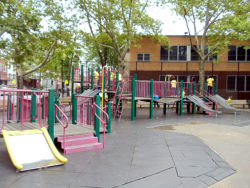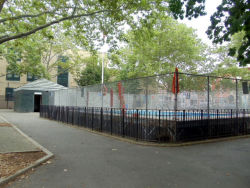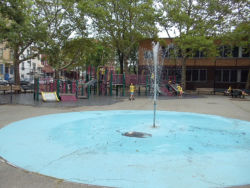Jesse Owens Playground
Jesse Owens Playground
Jesse Owens (1913-1980) was one of the greatest athletes of the 20th century. Born James Cleveland Owens on September 12, 1913 in Oakville, Alabama, and he changed his name when a grade school teacher mistook his initials “J.C.” for the name “Jesse”. The youngest child of sharecroppers, Owens and his family moved to Cleveland, Ohio in 1922, part of the African American exodus from the rural South. Under the guidance of Charles Riley, a junior high school teacher, Owens developed his athletic talents and took them to Cleveland East Tech High School. He was unbeatable at Cleveland East, but he was more than a high school star. He tied a world record in 1933, running a 9.4-second 100-yard dash at the National High School Championships.
Owens went on to Ohio State University, running track on a scholarship as a Buckeye. He won eight National Collegiate Athletic Association (NCAA) titles, but he gave his greatest performance at the 1935 Big Ten Conference Championships. Owens set or tied four world records: the 100-yard dash, the 220-yard dash, the 220-yard low hurdles, and the long jump. He went to the brand new NYC Parks stadium on Randall’s Island and won the Olympic trials.
In 1936, Germany hosted the Olympic Games in Berlin. Adolph Hitler had been leading Germany for three years, and was using his racial policies to sterilize people with physical and mental disabilities, and restrict Jews from universities and government jobs. These laws were the foreshadowing of the Holocaust, and they were based on the Aryan ideal of racial purity that was central to Nazi philosophy. Hitler saw the Berlin Olympics as the perfect stage to demonstrate German strength and Aryan superiority to the world. This was the moment Jesse Owens stepped into, and his extraordinary prowess propelled him into history.
He won four gold medals. He set Olympic records in the 200-meter dash and long jump, tied a world record in the 100-meter dash, and was part of the world record-breaking 4x100-yard relay team. Germany won more medals than any other country, but it was Owens that the world applauded. The track team was welcomed home on September 3, 1936, with a tickertape parade through lower Manhattan’s “Canyon of Heroes.” Owens was in and out of personal prosperity for the rest of his life, but he remained a national hero and an African American icon. He died of cancer on March 31, 1980, leaving behind his wife, Ruth Solomon, and their three daughters.
Jesse Owens Playground, on Stuyvesant Avenue and Lafayette Avenue, adjoins P.S. 26 and J.H.S. 57. The city acquired this land by condemnation in 1952, and the playground originally included a school garden, a play area with a sandpit and see-saws, a softball diamond, a skating area, a wading pool, swings, basketball and handball courts, and a public restroom, which was rehabilitated in 1970.
NYC Parks named this playground for Jesse Owens on June 18, 1987, and jointly operates the facility with the Department of Education. In 2014, NYC Parks announced that this site was part of Parks' Community Parks Initiative—a multi-faceted program to invest in under-resourced public parks and increase the accessibility and quality of parks throughout the five boroughs. This project reconstructed the play equipment, spray shower, synthetic turf field, painted track, as well as the plantings and furnishings at Jesse Owens Playground.
Check out your park's Vital Signs
Clean & Safe
Green & Resilient
Empowered & Engaged Users
Share your feedback or learn more about how this park is part of a
Vital Park System



